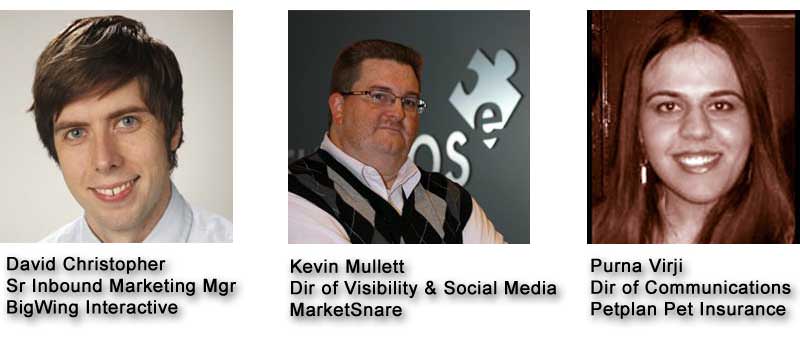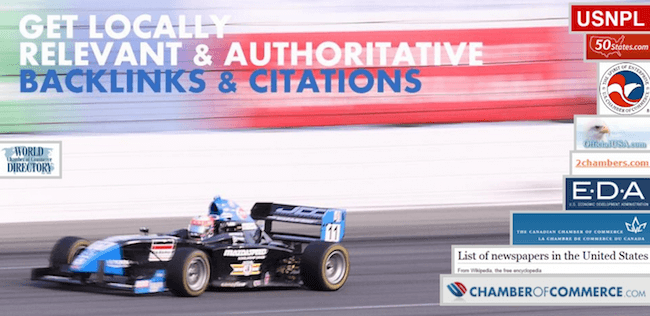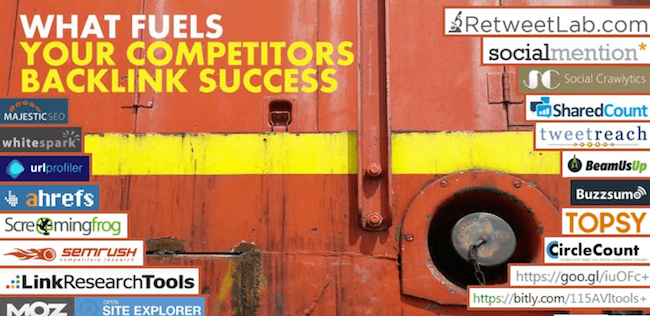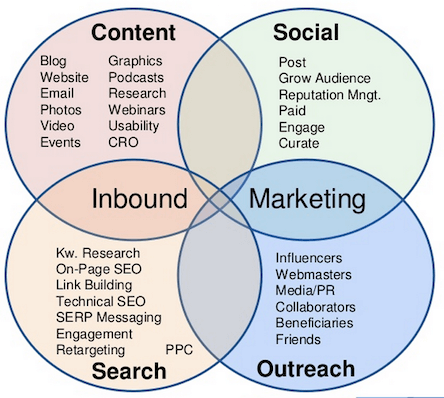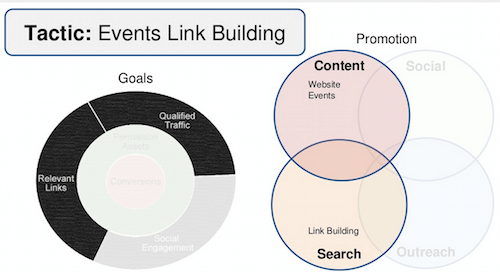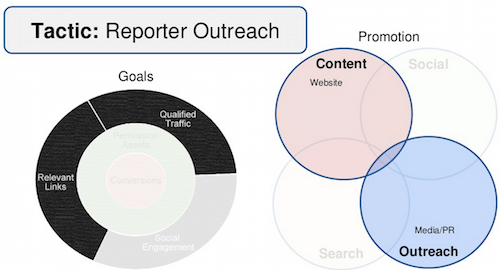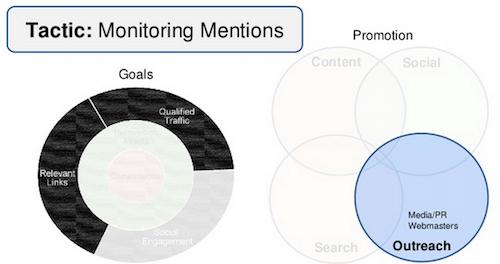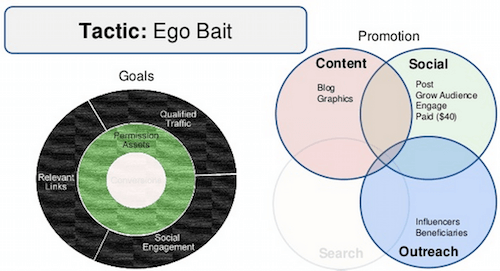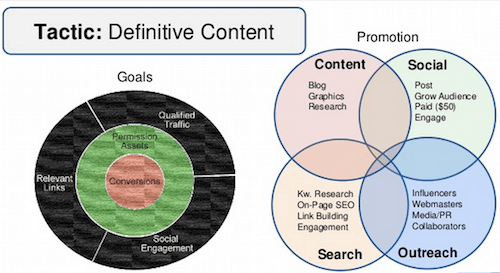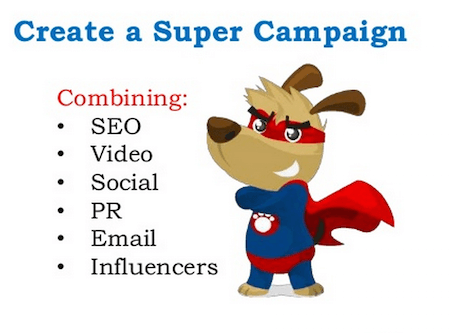Content Marketing & Promotion To Drive Quality Links: Up Close @SMX West
Contributor Mark Traphagen recaps a session from SMX West 2015 on how to create link-worthy content.

I’m old enough to remember a late 70’s TV commercial for investment firm Smith Barney, featuring veteran actor John Houseman.
Houseman, reincarnating his iconic role as the crusty Professor Kingsfield from the movie The Paper Chase, admonishes the viewers, bellowing that “good investments don’t walk up, bite you on the bottom, and say, ‘we’re here.'” He closed his mini-lecture with the tag line from the ad series: “Smith Barney, they make money the old fashioned way: they earn it.”
With the advent of Google’s Penguin updates and manual link penalties, earning links (instead of buying or manipulating them) is more the new-fashioned than old-fashioned way.
At SMX West 2015 in San Jose, three experts at creating and promoting content showed how they did so in ways that drove high quality links to the sites of their employers or clients. As a result, the search engine power of those sites rose dramatically.
The panel was made up of:
- David Christopher, Senior Inbound Marketing Manager, BigWing Interactive (@davidmchris)
- Kevin Mullett, Director of Visibility and Social Media at MarketSnare (@kmullett)
- Purna Virji, Director of Communications, Petplan Pet Insurance (@purnavirji)
How To Create Content That Earns Shares, Backlinks, & Citations (Kevin Mullett)
Kevin Mullett says that content marketing is not (just) blogging. It comes in a great many forms, some of them highly disguised. For example, The LEGO Movie was a content marketing piece on a grand scale. It was actually a 100-minute toy commercial disguised as a feature film.
Creativity isn’t the sole determinant of content marketing’s success; SEO plays an important role, too. It doesn’t replace good content, but, without it,before your good content isn’t reaching everyone it could. So the goal is to produce content that people will love, remember, and share, but at the same time earn the signals that enable that content to be easily found by a larger audience.
Actually, every site has two audiences. The first is live humans who can purchase your stuff. The second is the search bots. The bots have to ascertain if your site is functioning and if your content is relevant. To be successful, you have to earn the respect of both audiences.
For the live human audience, you capture attention by solving people’s problems, answering their questions, evoking their emotions, and entertaining them.
Here’s how Mullett defined each of these:
- Solve people’s problems by providing data or information they couldn’t get on their own.
- Answer questions that your customers and prospects actually have. Your front line people get asked questions all the time. Are the answers to those frequently-asked questions on your site? That’s backlink-worthy content and also builds your relevancy and authority.
- Evoke emotion with commentary that stirs people, that brings others into the conversation. Make them the hero.
- Entertain by turning the mundane into the magnificent. Think of the Will It Blend? campaign by Blendtech. Grinding up everything from iPads to golf clubs in their blenders drove huge number of shares, links and citations.
Being useful to your audience is not a trick or a trend. It is “certified algo-proof.” No one who is super useful needs to buy links.
Next, Mullett suggested getting your employees involved, encouraging them to be advocates and brand flame-fanners on their own social networks. Use the acronym “HELP” to guide this process:
- Humanize your message
- Encourage conversation
- Listen first,
- Promote less
Your most useful content will come from your front line people who hear what your customers and prospects are asking for.
You can unlock valuable backlinks with the right content for the right audience with the right content type in the right place and at the right time.
There are a huge variety of content types beyond just blog posts. Also think about:
- listicles
- infographics
- memes
- videos
- eBooks
- podcasts
- guides
- white papers
- polls
- how-to’s
- reviews
- stories
The right audience for your content is based on many factors, including:
- context
- relevance
- market location
- segmentation
- buying intent
- buying cycle
The right place for your content isn’t just your blog. It may also be:
- specific landing pages
- marketing pages
- event pages
- news
- FAQ’s
- embedded media
- off-site (with links and/or citations to your site)
The right times for your content include:
- special events
- seasons
- holidays
- news-jacking
- trends-jacking
- campaigns
- lead nurturing
- funnel
- buying cycle
- any time you have people’s attention
Finally, Mullett recommended dozens of tools that can help with content creation and promotion, as shown in the images within the following screen captures from his presentation.
1. Tools that help get locally-relevant & authoritative backlinks & citations
2. Tools for organizing and optimizing your content opportunities
Mullett invited the audience to try out his agency’s free Content Opportunity Report template, which helps organizations spot and prioritize content opportunities for their editorial calendars.
3. Tools for finding competitive backlink opportunities
Here is Kevin Mullett’s full slide deck from his presentation:
https://www.slideshare.net/slideshow/embed_code/45347316
Link Building Tactics From 10,000 Hours Of Content Marketing (David Christopher)
BigWing Interactive, David Christopher’s agency, used to center on link building. It used a simple checklist for effective links that they could easily train any worker to follow. But their customers were still getting hit by Penguin. Their link builders were becoming demoralized, both by the constant defeats and the mundane nature of their tasks.
One employee commented on a survey: “I’ve simply lost the ‘why.'”
They retooled to become an agency centered on content marketing, with link building seen more as the result of brilliant content marketing rather than as an end in itself. They report to clients on content marketing activities rather than just links built. They found that this led to better client understanding of the whole process.
A nice byproduct of that switch was much happier agency employees. Their workers now feel like they are involved in a creative process, building “cool stuff” rather than just following a mechanical link building process.
They ask two questions when planning content:
Question 1: What Is The Goal Of This Content?
Five goals: conversions at the center, then permission assets, surrounded by qualified traffic, relevant links, and social engagement. But they all need to work toward driving conversion.
Question 2: What Is The Promotion Plan?
The four aspects of content promotion — Content/Social/Outreach/Search — all result in inbound marketing (attracting qualified prospects to your business).
A content marketer needs to have solid content creation skills, but also an understanding of social media and search, as well as real marketing. Driving an audience for the content is now part of the content marketing job.
Businesses need to understand their present audience is only a tiny subset of their potential customers. They have to have the goal of reaching to the desirable audience that has some overlap with their existing audience. In other words, the existing audience is the business’s connection to the desired audience.
The content marketer now also has these roles also:
- Blogger: at the intersection of Content and Social.
- Social Media Marketer: at the intersection of Social and Outreach.
- Link Builder: at the intersection of Outreach and Search.
- SEO: at the intersection of Search and Content.
Transitioning Link Builders To Content Marketers
More and more businesses are realizing they have to move from straight-up link building to content marketing. It can be difficult to transition staff from the link building skill set and mindset to a content-centric strategy. BigWing found they were able to successfully move a little over a quarter of their former link builders into content marketing. The rest either quit, were laid off, or moved into SEO instead. It was a painful transition, but it has paid off multiple times over.
Next, Christopher shared some link building tactics his company uses now that grow out of its content marketing practices.
Tactic: Events Link Building
One problem with links to event landing pages is that they are often no-followed or disappear over time. (However, as Rand Fishkin showed in a Whiteboard Friday video, link echoes — or ghosts — appear to be real. In some cases, rankings can be retained even after links disappear.)
BigWing found the better solution to be focusing on creating high quality content emerging from the event. Doing that resulted in more valuable links that drove qualified traffic.
Tactic: Reporter Outreach
The first step is to create a profile page for each of the brand’s authority sources (their experts) so that journalists can easily vet the source. Include a photo, the person’s experience and specific expertise, and list any significant publications and speaking events. This will help make journalists feel more confident about quoting or citing your experts.
Also create preemptive content anticipating things about which reporters will be writing. Then, you can be first with a relevant resource to offer when you see a request from a journalist via something like HARO.
Finally, be sure to include both the already-existing quotable resource and a link to the author’s profile page in outreach emails to reporters.
In one campaign, BigWing got a client’s disaster preparedness guide for pet owners mentioned by 49% of the journalists they pitched, and nearly a third of those provided a link. BigWing also typically asks for a link to the author’s profile page to help build the authority of that author.
Tactic: Monitoring Mentions
In this tactic, you monitor the web for mentions of your brand that currently contain no link and see if you can convince them to link to your site. Of course, first you have to find those mentions.
A simple first step is to do a Google search for your brand name. Use the -site: operator to remove any references by your own domain. So if your brand is XYZ Filters and your site domain is xyzfilters.com, you would search using [“xyz filters” -site:xyzfilters.com]. Also, set the time filter under the Search Tools tab to “past month” or more recent to get the most recent results.
An advanced tactic for making it more likely that you will get a link when reaching out to sites who have mentioned you is to first build a custom landing page that relates to the specific reason for which they gave you the mention.
Tactic: Link Bait
In this tactic, you create content that you believe will be especially attractive to a targeted set of publishing sites, then reach out to them offering the content.
Tactic: Ego Bait
Ego bait is content that favorably mentions targeted influencers. Be sure to reach out to them and let them know they were mentioned. In one campaign, 10 of 25 influencers mentioned and reached out to by BigWing shared and/or linked to the post.
Tactic: News Jacking
For one client, BigWing created a humorous campaign centered around the puppet of a ventriloquist who was advanced by American Idol judges who at the same time rejected the puppeteer. The content piece attracted numerous links with an average domain authority of 73. Key here was jumping quickly to create entertaining content about a trending topic.
Tactic: Definitive Content
Definitive content is content that covers a given topic in a way and to an extent that exceeds anything else available online. BigWing is spending the most time on definitive content now because it uses all the disciplines and meets all the goals.
To create definitive content, ask yourself: Has it been done already, but can we do it better?
For a client seeking to connect with homeowners in Colorado Springs, BigWing noticed that the only online reference to the city’s incredible annual Christmas lighting displays was a very thin and poorly-designed page. So they created a very detailed, useful, and attractive “Colorado Springs Christmas Lights Guide.” As their page was far more useful and attractive, it attracted links and many positive references, and very quickly it outranked the other page.
Side tip: Involve others in your content creation. While researching the topic for the above-mentioned comment, the author posted on Reddit asking for users there to contribute great Colorado Springs light displays the author might have missed. Once the piece was published, the author posted the link in the same Reddit thread, thanking all those who contributed. That resulted in significant referral traffic from Reddit.
BigWing also did outreach to thirty Colorado Springs homeowners’ associations, twenty of which either contributed suggestions or linked to the guide.
In this case, their definitive content was so good, even the competing site that had inspired it ended up linking to it!
Conclusion
The age old problem: “Nobody wants to link to my site.” Answer: You have to build linkable assets.
For their clients, 39% of conversions still come from organic search. You simply can’t afford to ignore search.
https://www.slideshare.net/slideshow/embed_code/45347315
Content Marketing To Drive High Quality Links (Purna Virji)
At PetPlan, they seek to create super campaigns that merge multiple marketing disciplines.
Purna Virji walked us through a case study in which they reached millions of people and got dozens of high quality links, as well as lots of PR and shares.
Their campaign centered around news about the growing epidemic of pets deaths resulting from pets left unattended in cars. They knew this was natural linkbait for SEO and sharebait for social, but they wanted to go beyond relying on those two things. Their tactic is to “think big” — to dig into the story more deeply than anyone else.
For this campaign, they did extensive research and found out only fifteen states have laws about pets in cars. They now had a compelling story to tell. Actually, more than a story, they now had a cause that people could rally around.
Their next step in thinking big was the decision to initiate a federal petition, using the White House’s recent promise to give attention to any petition that collected at least 100,000 signatures. That was an ambitious goal, but for that very reason they knew the payoff could be huge. To get that level of response, they knew they needed to be everywhere.
But their big thinking didn’t stop there. What other campaign goals could they include? They wanted to go beyond a normal campaign to create a super campaign combining many marketing disciplines.
Initial outcome was “Driven to Bark,” a landing page that provided much more information and content than the government petition site allowed. So instead of driving traffic directly to the petition, they drove it to this landing page where they could potentially involve the user in much more than just signing the petition.
So now they had two conversion goals: get visitors to sign the petition, but also share the campaign.
Campaign Reinforcement
The next step was to build complementary assets and mini-campaigns to drive up the effectiveness of the main campaign.
They created an infographic and downloadable PDF to make the campaign more sharable.
They also sent out an email blast to their subscribers and created a press release.
Results
The campaign far exceeded all its goals. They got major media coverage which helped the petition exceed its signature goal. That resulted in even more press coverage.
From all they learned from that campaign they created a replicable model so they could create future campaigns without starting from scratch every time.
How You Can Create Super Campaigns
Virji shared the following steps that she says any brand could follow to create their own super campaigns:
- Start with a channel-agnostic concept. Don’t start with “we need a video.” Brainstorm without limitations.
- Understand the audience and your amplifiers. What will entertain, educate, and move them to share? Remember you don’t just want traffic; you want relevant traffic.
- Identify the overall goals and KPIs. Make sure your content fits them.
- Tailor the concept to fit different media. Think about how it would look as a video, as an email, as an infographic, etc.
- Map out the project plan and distribution schedule to ensure cross-channel synergies.
The Ingredients of Super Campaigns
These are the individual ingredients you can stir together to create a multi-channel, multi-discipline super campaign that will earn you quality links and qualified traffic:
- Landing pages: Share relevant info and be “meaty.” Goal is to earn links.
- Video: Video is great for making an emotional connection. Also an ideal medium for easily explaining the concept. Great for YouTube and Facebook.
- Pin-able content: Not only can Pinterest be a powerful place to spread your campaign, Pinterest-friendly images will also raise the visual appeal of your landing pages.
- Social media assets: Fastest way to spread word of your campaign. Side benefit: a successful campaign builds audience for future campaigns.
- E-Blasts: Using your email list drives action. Forwarding is the email equivalent of social sharing; be sure to ask your recipients to forward to their friends.
- Downloadable PDFs: Downloadable content is a tangible takeaway that feels more valuable, and thus is more likely to be read and acted upon.
- PR pitches: Getting talked about in prominent publications adds credibility and prestige to your campaign, and can be a great source of valuable links.
- List of influencers: Where possible, use ego bait to draw in influencers. Great access to audiences you don’t yet have.
- Paid social ads: Great way to reach a targeted audience directly, and get the buzz going.
Timing Matters
In a super campaign you have to time things carefully to maximize the synergistic effect. Virji provided a sample calendar from one of their campaigns:
- Graphics and video prepared: at least three weeks before launch.
- Media outreach initiated: two weeks before launch.
- Blogger outreach initiated: one week before launch.
- Employee sharing of content: day of launch.
Summary
- Take a core idea.
- Consider how the audience will find it.
- Adapt the idea into different forms.
- Get different teams involved.
- Seed it everywhere that applies.
- Leverage influencers to amplify sharing.
Here is Purna Virji’s slide deck from this presentation:
Contributing authors are invited to create content for Search Engine Land and are chosen for their expertise and contribution to the search community. Our contributors work under the oversight of the editorial staff and contributions are checked for quality and relevance to our readers. The opinions they express are their own.
Related stories
New on Search Engine Land

